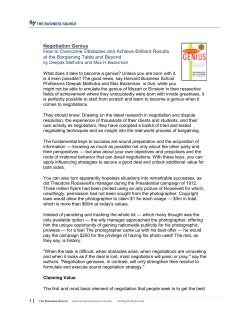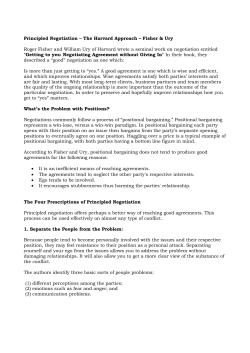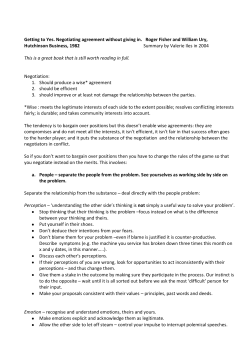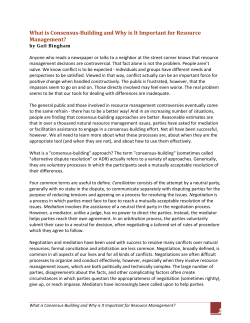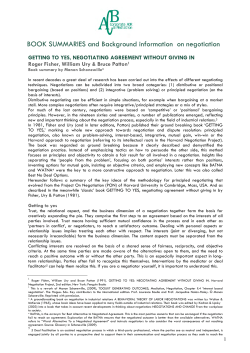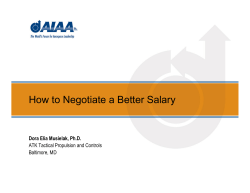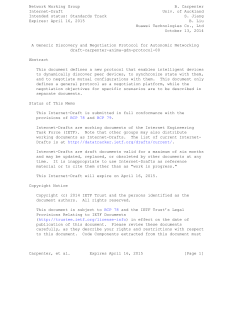
Negotiation: how it works (or doesn’t work) for
Negotiation: how it works (or doesn’t work) for women and why it matters Summary Negotiation is a common requirement in most people's working days. Employees negotiate for resources for their teams, on dates for project timelines, scope, strategy and tactics, on system requirements and in relation to budgets. The ability to navigate these routine negotiations contributes to the effectiveness of job delivery. However, the personal stakes are much higher when it comes to negotiations that affect career progress, including salaries, promotions, working arrangements and learning and development opportunities. Research shows there is considerable disparity between women and men when it comes to the approach taken during negotiations and their outcomes. Indeed, studies show that women tend to have less successful outcomes than men. Less successful negotiation outcomes for women contribute to the current gender inequality between women and men evidenced by the lack of women in senior workplace roles, the persistent gap between the salaries of women and men and the higher numbers of women living in poverty in their old age. This paper examines some ideas and issues around gender and negotiation, and demonstrates the importance of understanding the gendered nature of negotiation. It identifies the need to address gendered barriers. It also presents strategies that can be adopted by both employees and employers with the aim of improving negotiation outcomes for women and men. The position of women in Australian workplaces today Women hold fewer senior positions in Australian workplaces than men, earn lower wages on average and retire with lower savings. They make up 46% of the workforce, 1 but hold only 16.4% of board roles in the top 200 organisations listed on the Australian Securities Exchange 2 and only 3.5% of CEO roles. 3 The full-time average weekly earnings of women are currently 17.5% less than those of men 4 and this gap has not shifted significantly in two decades. On average women’s lifetime earnings are less than men’s. As a result, when women retire, they have much lower levels of savings compared to male retirees 5 and are more likely to rely on government financial assistance. 6 The reasons for these gendered disparities are complex and multifaceted and played out over the life course. However, less successful negotiation outcomes for women are likely to be a contributing factor to the career advancement gender gap. 7 While negotiation can be required in everyday working life, the difference between women’s and men’s negotiation approaches and outcomes has significant implications for gender equality in the workplace, because they can determine outcomes such as formal employment conditions, promotions, flexible working arrangements, training and development opportunities, and workplace issues. Workplace Gender Equality Agency | Women and negotiation | www.wgea.gov.au 1 Why are women less successful negotiators? While there is no evidence to suggest that women’s abilities to negotiate are any different from men’s, women’s negotiations still tend to be less successful than men’s. It seems that women are not inherently less willing to negotiate but in workplace contexts women are reluctant to enter into negotiation. 8 When they do negotiate for themselves, they ask for less and are more likely to accept an initial offer rather than attempt to negotiate it to be more in their favour. 9 And while negotiating might lead to better economic outcomes in the short term for women, these economic resources come at a social cost. In essence, women are damned if they do negotiate and “doomed” if they don’t. 10 Gender stereotypes Gender stereotypes are a key factor in understanding negotiation failures for women. Gender stereotypes describe how men and women are perceived and how they should and should not behave. Women are generally perceived as communal (caring, communicative and encouraging) and men as agentic (ambitious, assertive, decisive and selfreliant). 11 Negotiation is usually associated with agentic, and therefore masculine, behaviour. When employers negotiate with women, they tend to offer less and are more likely to resist influence attempts. 12 At the same time, there is nothing to suggest that communal qualities are not also important when negotiating in some circumstances. 13 For example, women seem more successful negotiating on matters that are considered feminine compared to those considered masculine. However, discussions around compensation may be negatively affected by this. 14 Stereotype backlashi Women’s reluctance to enter negotiations is partly because they are penalised more than men for doing so. Studies have shown that women’s reluctance to enter negotiations is partly because they are penalised more than men for doing so. 15 Because negotiation involves agentic behaviours, women who negotiate must operate outside prescribed gender norms, and can experience backlash for doing so in the form of economic and social penalties (e.g., they can be viewed as hostile, selfish, devious and quarrelsome). 16 Women who negotiate agentically can be disliked and some colleagues may not want to work with them. 17 This loss of social capital has economic implications for these women who may not be hired or offered promotions, despite being competent, because they are perceived as lacking in social skills. 18 Women are aware of this backlash and try to avoid it. 19 The more women anticipate backlash, the less inclined they are to initiate negotiations. 20 Women are not necessarily less competitive than men Although women may be less inclined to undertake negotiations, they are not necessarily less competitive than men in negotiations. 21 A review of research looking at bargaining behaviour found that when there was little or no contact between the participants, negotiator competitiveness was comparable for women and men. Only in face-to-face negotiation environments were there lower levels of female negotiator competitiveness. 22 Keys to unlocking women's negotiating skills While women are subject to backlash when they negotiate for themselves, they experience more negotiation success when they advocate for others. 23 This seems to be because when advocating for others women are acting within expected gender norms as they are seen as helping others. 24 When advocating for others, women negotiate harder and give in less than when they are negotiating for themselves. 25 Reducing levels of ambiguity around negotiation can change the gendered nature of negotiation outcomes, 26 and training may also assist to reduce this. 27 The organisational strategies discussed later in this paper aim to help achieve this. Research 28 suggests that women are willing to negotiate in general and strategies can be implemented by organisations and employees to improve outcomes. i This refers to situations where women are penalised, socially or financially, for contravening what is seen as ‘normal’ behaviour for their gender, in this case by initiating negotiations or negotiating strongly. Workplace Gender Equality Agency | Women and negotiation | www.wgea.gov.au 2 Benefits to be gained by addressing issue Individuals If women undertook negotiations at work more and obtained better outcomes from them, this should contribute to reducing the gender pay gap and gender differences in representation across industries and job types, leading to greater economic equality between women and men throughout their lives. Organisations Talent shortages exist in the Australian workforce. 29 Attracting and retaining the best employees from the entire talent pool means attracting and retaining women as well as men. But where women anticipate difficulties with work-life balance or career opportunities, they may opt out of careers rather than enter into negotiations, contributing to increased organisational turnover. 30 And if women on entry to an organisation or on promotion consistently obtain poorer pay negotiation results than men, attempts to reduce the gender pay gap in organisations will be undercut. In contrast, a positive diversity ‘climate’ assists businesses to retain staff, with women and men both preferring to stay with an employer they view as fair. 31 Perceived fairness is more likely to exist where women can negotiate as successfully as men in an organisation. Where an organisation promotes gender equal negotiation outcomes, this contributes to eliminating women’s lower pay and lesser access to, for example, promotions. The implementation of practices to ensure women had access to the same resources as men resulted in American firm Deloitte and Touche being able to reduce the turnover rate of women to match that of men. 32 Promoting fair negotiations helps organisations achieve gender diversity at all levels of business, particularly senior levels, which is considered a critical requirement for strong organisational performance, but one that is often disregarded. 33 Organisations that achieve gender diversity at these senior levels enjoy increased innovation, creativity and improved decision-making. 34 Strategies/options for addressing the issue There is an active debate in the literature about whether women or employers should change to improve negotiation outcomes for women. Some people argue that women should “lean in” to succeed by speaking up, showing their skillset and asking for what they want. 35 They suggest that gender disparities can be addressed by explicitly changing women’s behaviour. Others criticise this “fix the women” approach and argue that organisations need to make significant changes to give women more room to negotiate. 36 In reality, a holistic approach combining both strategies is required if improved negotiation outcomes for women are to occur. Below are strategies for both organisations and employees to implement to reduce or prevent the backlash experienced by women when entering into negotiations. There is an active debate about whether women or employers should change to improve negotiation outcomes for women. WGEA believes both organisations, and individuals should be encouraged to play a role. Strategies for women First steps Women need to acknowledge and overcome any reluctance to negotiate. They should steel themselves to enter negotiations even if the idea of doing so is unappealing. Thorough preparation will make engaging in negotiation easier. Practice Women can develop negotiation skills in one-off, low-value transactions, such as negotiating a discount for a damaged item at a shop. Practising answers to questions in advance of negotiating at work is also useful, particularly in relation to salary and the need for additional resources. Use a coach if possible. Rehearsing helps negotiation language and techniques come more easily. Women can also take up any opportunities for negotiation skills training offered by their employer. Workplace Gender Equality Agency | Women and negotiation | www.wgea.gov.au 3 Be informed Women can bring objective data, such as a recent salary survey conducted by a professional organisation, to negotiations. Knowledge of what the going rate is in the organisation conducting negotiations is also valuable and can be used expressly or implicitly. Data provide a focus for the negotiation and reduces the need for strong, aggressive bargaining. Be prepared Women can identify in advance their value to the organisation illustrating their strengths and how they are in line with the organisation's needs. It is important to make sure fall-back positions are worked out in advance of commencing negotiations, by thinking through priorities and trade-offs. Research also suggests it can be helpful to refer to another person in the organisation more senior than the woman negotiating as having suggested negotiations (where that is possible). 37 Strategies for organisations Understanding the steps needed to improve negotiation outcomes for women is linked to understanding how organisations are performing on gender equity overall. WGEA has a range of resources to assess whether business policies and practices align with those needed to perform optimally, and whether different outcomes for women and men are occurring. For example, to understand if an organisation has a gender pay gap, use the payroll analysis tool. Negotiations: transparency and limits If negotiations over salary and other agreed items are possible or expected in an organisation, employers should make sure employees and new recruits know this. ii This can increase the likelihood that women will enter into negotiations. 38 Organisations can also encourage women to negotiate when they ensure managers and employees understand the extent to which salary, flexible workplace conditions, leave, training opportunities and bonuses can be negotiated. Transparent criteria for pay increases and bonuses and limited managerial discretion is good pay equity practice. Such practices also help women reduce or eliminate backlash they may otherwise experience when negotiating. 39 They can also reduce the ambiguity around whether negotiation is acceptable and whether topics are masculine, feminine or gender neutral. 40 Redefine the skills which make a good negotiator Organisations can assist women by redefining the qualities that make a good negotiator. This process is called “stereotype regeneration”. 41 Acknowledging the value of stereotypical female traits can change the way women and men negotiate and reduce the need for aggressive competitive negotiation behaviour. 42 Traits include: good listening skills high emotional intelligence excellent communication skills understanding negotiator and negotiation partner feelings open expression of thoughts. When feminine traits are explicitly highlighted as high performance traits for negotiation, women become more confident, set higher goals for themselves and achieve better outcomes. 43 Management teams within organisations can achieve stereotype regeneration through training that makes staff aware of negotiation stereotypes and conveys the strengths of feminine traits. ii The phrase “opportunity for negotiation” appears more intimidating to women than the phrase “opportunity for asking” Small, D. A, Gelfand, M., Babcock, L., & Gettman, H. (2007). Who goes to the bargaining table? The influence of gender and framing on the initiation of negotiation. Journal of personality and social psychology, 93(4), 600–13. Workplace Gender Equality Agency | Women and negotiation | www.wgea.gov.au 4 Provide training Catalyst 44 believes increasing awareness of gender stereotypes through education of managers and employees can reduce the effect these stereotypes have on behaviour. Programs should teach managers and employees how to recognise stereotypes and bias, how their behaviour might contradict their gender equality values and how gender inequality impacts women. 45 Once aware of these biases, managers and employees can then reflect on their immediate responses, so that previously automatic (biased) responses become considered ones reducing the chance for prejudice to influence them. 46 Employers can also give employees practical help by providing training in negotiation skills, specifically addressing techniques women can use effectively. This can also embed an organisation’s strategy to redefine what makes a good negotiator. Conclusion Maximising negotiation outcomes for women is an important issue for organisations and women. Employers need to recognise and address the obstacles women face when negotiating to help maximise positive outcomes from their investments in other gender equality initiatives. Women who are able to negotiate in environments that support them will achieve better long term economic and career outcomes. Workplace Gender Equality Agency | Women and negotiation | www.wgea.gov.au 5 1 Workplace Gender Equality Agency. (2013), Gender workplace statistics at a glance, viewed 20 September 2013, www.wgea.gov.au/sites/default/files/2013-02%20-%20Stats%20at%20a%20glance.pdf 2 Australian Institute of Company Directors. (2013), Statistics, viewed 31 October 2013, www.companydirectors.com.au/Director-Resource-Centre/Governance-and-Director-Issues/Board-Diversity/Statistics 3 Equal Opportunity for Women in the Workplace Agency (EOWA, now the Workplace Gender Equality Agency) (2012), Australian Census of Women in Leadership, Sydney, EOWA , viewed 20 September 2013, www.wgea.gov.au/sites/default/files/2012_CENSUS%20REPORT.pdf 4 Workplace Gender Equality Agency. (2013), Gender pay gap statistics, viewed 20 September 2013, www.wgea.gov.au/sites/default/files/2013-08-28Gender-Pay-Gap%20FINAL.pdf 5 Rice Warner (2012), Valuing females and rewarding them in retirement, Rice Warner Actuaries, viewed 20 September 2013, www.ricewarner.com/images/newsroom/1354152211_Valuing%20Females%20and%20Rewarding%20them%20in%20Retirement.pdf 6 Rice Warner (2012), Valuing females and rewarding them in retirement, Rice Warner Actuaries, viewed 20 September 2013, www.ricewarner.com/images/newsroom/1354152211_Valuing%20Females%20and%20Rewarding%20them%20in%20Retirement.pdf; Jefferson, T (2005), ‘Women and Retirement Incomes in Australia: A Review’, The Economic Record, vol. 81, pp. 273–291. 7 Stroh, LK, Brett, JM, Reilly, AH (1992), ‘All the right stuff: A comparison of female and male managers’ career progression’, Journal of Applied Psychology, vol. 77, pp. 251–260; Carter, NM & Silva, C (2011), The myth of the ideal worker: Does doing all the right things really get women ahead? Catalyst; Johnston DW & Lee W-S (2011) Climbing the Job Ladder: New Evidence of Gender Inequity, IZA Discussion Paper No. 5970, Bonn, Institute for the Study of Labor. 8 Small, Da, Gelfand, M, Babcock, L, Gettman, H (2007), ‘Who goes to the bargaining table? The influence of gender and framing on the initiation of negotiation’, Journal of personality and social psychology, vol. 93(4), pp. 600–13; Bowles, HR, Babcock, L, Lai, L (2007), ‘Social incentives for gender differences in the propensity to initiate negotiations: Sometimes it does hurt to ask’, Organizational Behavior and Human Decision Processes, vol. 103, pp. 84–103. 9 Eckel, C, Oliveira, ACMDe, Grossman, PJ (2008), ‘Gender and negotiation in the small: Are women (perceived to be) more cooperative than men ?’, Negotiation Journal, vol. 24, pp. 429–445; Kray, LJ & Thompson, L (2005), ‘Gender stereotypes and negotiation performance: An examination of theory and research’, In BM, Staw & RM, Kramer (Eds.), Research in Organizational Behavior: An Annual Series of Analytical Essays and Critical Reviews, pp. 103–182. 10 Catalyst (2007), The double-bind dilemma for women in leadership: Damned if you do, doomed if you don’t, pp. 1–48. 11 Genat, A, Wood, R, Sojo, V (2012), Gender equality project: Evaluation bias and backlash, pp. 1–52; Rudman, LA, & Phelan, JE (2008), ‘Backlash effects for disconfirming gender stereotypes in organizations’, Research in Organizational Behavior, vol. 28, pp. 61–79. 12 Solnick, SJ (2001), ‘Gender differences in the ultimatum game’, Economic Enquiry, vol. 39, pp. 189–200; Glick, S. & Croson, R. (2001). Reputations in negotiation, in S.J. Hoch, H. C. Kunreuther & R. E. Gunther (Eds), Wharton on Making Decisions, pp177-186. New York, Wiley & Sons. 13 Stuhlmacher, AF & Linnabery, E (2013), ‘Gender and negotiation: A social role analysis’, Handbook of Negotiation Research, pp. 1–45. 14 Bear, J (2011), ‘“Passing the buck”: Incongruence between gender role and topic leads to avoidance of negotiation’, Negotiation and Conflict Management Research, vol. 4(1), pp. 47–72; Bear, JB & Babcock, L (2012), ‘Negotiation topic as a moderator of gender differences in negotiation’, Psychological science, vol. 23(7), pp. 743–4. 15 Bowles, HR, Babcock, L, Lai, L (2007), ‘Social incentives for gender differences in the propensity to initiate negotiations: Sometimes it does hurt to ask’, Organizational Behavior and Human Decision Processes, vol. 103, pp. 84–103. 16 Rudman, LA & Phelan, JE (2008), ‘Backlash effects for disconfirming gender stereotypes in organizations’, Research in Organizational Behavior, vol. 28, pp. 61–79. 17 Heilman, ME, Wallen, AS, Fuchs, D, Tamkins, MM (2004), ‘Penalties for success: Reactions to women who succeed at male gender-typed tasks’, Journal of Applied Psychology, vol. 89, pp. 416; Genat, A, Wood, R, Sojo, V (2012), Gender equality project: Evaluation bias and backlash, pp. 1–52. 18 Heilman, ME, Wallen, AS, Fuchs, D, Tamkins, MM (2004), ‘Penalties for success: Reactions to women who succeed at male gender-typed tasks’ Journal of Applied Psychology, vol. 89, pp. 416. 19 Rudman, LA & Fairchild, K (2004), ‘Reactions to counterstereotypic behavior: The role of backlash in cultural stereotype maintenance’, Journal of personality and social psychology, vol. 87, pp. 157–76; Moss-Racusin CA & Rudman, LA (2010). ‘Disruptions in Women's Self-Promotion: The Backlash Avoidance Model’, Psychology of Women Quarterly, vol. 34, pp. 186-202. 20 Bowles, HR, Babcock, L, Lai, L (2007), ‘Social incentives for gender differences in the propensity to initiate negotiations: Sometimes it does hurt to ask’, Organizational Behavior and Human Decision Processes, vol. 103, pp. 84–103. 21 Walters, AE, Stuhlmacher, AF, Mayer, LL (1998), ‘Gender and negotiator competitiveness: A meta-analysis’, Organizational Behavior and Human Decision Processes, vol. 76(1), pp. 1–29; Carter & Silver (2011), The Myth of the Ideal Worker, Catalyst, US. 22 Walters, AE, Stuhlmacher, AF, Mayer, LL (1998), ‘Gender and negotiator competitiveness: A meta-analysis’, Organizational Behavior and Human Decision Processes, vol. 76(1), pp. 1–29. Workplace Gender Equality Agency | Women and negotiation | www.wgea.gov.au 6 23 Amanatullah, ET & Tinsley, (2013), ‘Punishing female negotiators for asserting too much...or not enough: Exploring why advocacy moderates backlash against assertive female negotiators’, Organizational Behavior and Human Decision Processes, vol. 120, pp. 110–122; Bear, J (2011), ‘“Passing the buck”: Incongruence between gender role and topic leads to avoidance of negotiation’, Negotiation and Conflict Management Research, vol. 4(1), pp. 47–72. 24 Kulik, C & Olekalns, M (2012), ‘Negotiating the Gender Divide: Lessons From the Negotiation and Organizational Behavior Literatures’, Journal of Management, vol. 38(4), pp. 1387–1415. 25 Bowles, HR, Babcock, L, Mcginn, KL (2005), ‘Constraints and triggers: Situational mechanics of gender in negotiation’, Journal of Personality and Social Psychology, vol. 89 (6), pp. 951-965; Amanatullah, ET & Morris, MW (2010), ‘Negotiating gender roles: Gender differences in assertive negotiating are mediated by women’s fear of backlash and attenuated when negotiating on behalf of others’, Journal of personality and social psychology, vol. 98(2), pp. 256–67. 26 Bowles, HR, Babcock, L, Mcginn, KL (2005), ‘Constraints and triggers: Situational mechanics of gender in negotiation, Journal of Personality and Social Psychology, vol. 89 (6), pp. 951-965; Miles, EW & LaSalle, MM (2008), ‘Asymmetrical contextual ambiguity, negotiation self-efficacy, and negotiation performance’ International Journal of Conflict Management, vol. 19(1), pp. 36–56; Small, Da, Gelfand, M, Babcock, L, Gettman, H (2007), ‘Who goes to the bargaining table? The influence of gender and framing on the initiation of negotiation’, Journal of personality and social psychology, vol. 93(4), pp. 600–13. 27 Kulik, C & Olekalns, M (2012), ‘Negotiating the Gender Divide: Lessons From the Negotiation and Organizational Behavior Literatures’, Journal of Management, vol. 38(4), pp. 1387–1415. 28 See also Leibbrandt, A & List, JA (2012), Do women avoid salary negotiations? Evidence from a large scale natural field experiment, Cambridge, MA, viewed 9 October 2013, www.nber.org/papers/w18511 29 Manpower Group (2013), 2012 Talent Shortage Survey Research Results, viewed 9 August 2013: www.manpower.com.au/documents/WhitePapers/2013_Talent_Shortage_Survey%20Results_ANZ.pdf 30 31 Stuhlmacher, AF & Linnabery, E (2013), ‘Gender and negotiation: A social role analysis’, Handbook of Negotiation Research, pp. 1–45. Kaplan, DM, Wiley, JW, Maertz, CP (2011), ‘The role of calculative attachment in the relationship between diversity climate and retention’, Human Resource Management, vol. 50(2), pp. 271-287. 32 McCracken, D (2000), ‘Winning the talent war for women. Sometimes it takes a revolution’, Harvard Business Review (November-December), pp. 159-167. 33 Krishnan, GV & Parsons, LM (2007), ‘Getting to the Bottom Line: An Exploration of Gender and Earnings Quality’, Journal of Business Ethics, vol. 78(12), pp. 65–76. 34 Arfken, DE, Bellar, SL, Helms, MM (2004), ‘The Ultimate Glass Ceiling Revisited: The Presence of Women on Corporate Boards’, Journal of Business Ethics, vol. 50(2), pp. 177–186; Herring, C (2009), ‘Does diversity pay?: Race, gender, and the business case for diversity’, American Sociological Review, vol. 74, pp. 208–224; Page, S (2007), ‘Making the difference: applying a logic of diversity’, The Academy of Management Perspectives, pp. 6–21; Shen, J, Chanda, A, D’Netto, B, Monga, M (2009), ‘Managing diversity through human resource management: an international perspective and conceptual framework’, The International Journal of Human Resource Management, vol. 20(2), pp. 235–251. 35 Catalyst (2007), The double-bind dilemma for women in leadership: Damned if you do, doomed if you don’t, pp. 1–48; Sandberg, www.news.com.au/business/worklife/sheryl-sandberg-book-urges-women-to-lean-in-to-succeed/story-e6frfm9r-1226594438318 36 Catalyst (2007), The double-bind dilemma for women in leadership: Damned if you do, doomed if you don’t, pp. 1–48; Kolb, D. (2009) Too bad for the women or does it have to be? Gender and negotiation research over the past twenty-five years, Negotiation Journal, 25, 4, 515-531. 37 Bowles, HR, Babcock, H (2012), How Can Women Escape the Compensation Negotiation Dilemma? Relational Accounts Are One Answer, Psychology of Women Quarterly, vol. 37, pp.80-96. 38 Leibbrandt, A & List, JA (2012), ‘Do women avoid salary negotiations? Evidence from a large scale natural field experiment’, Cambridge, MA, Retrieved from http://www.nber.org/papers/w18511 39 Kulik, C & Olekalns, M (2012), ‘Negotiating the Gender Divide: Lessons From the Negotiation and Organizational Behavior Literatures’, Journal of Management, vol. 38(4), pp. 1387–1415. 40 Bowles, HR, Babcock, L, Mcginn, KL (2005), ‘Constraints and triggers: Situational mechanics of gender in negotiation’; Miles, EW & LaSalle, MM (2008), ‘Asymmetrical contextual ambiguity, negotiation self-efficacy, and negotiation performance’, International Journal of Conflict Management, vol. 19(1), pp. 36–56. 41 Kray, LJ, Galinsky, AD, Thompson, L (2002), ‘Reversing the gender gap in negotiations: An exploration of stereotype regeneration’, Organizational Behavior and Human Decision Processes, vol. 87(2), pp. 386–409 42 Kray, LJ & Thompson, L (2005), ‘Gender stereotypes and negotiation performance: An examination of theory and research’, In BM, Staw & RM, Kramer (Eds.), Research in Organizational Behavior: An Annual Series of Analytical Essays and Critical Reviews, pp. 103–182 43 Kray, LJ, Galinsky, AD, Thompson, L (2002), ‘Reversing the gender gap in negotiations: An exploration of stereotype regeneration’, Organizational Behavior and Human Decision Processes, vol. 87(2), pp. 386–409; Shih, M, Young, MJ, Bucher, A (2013), ‘Working to reduce the effects of discrimination: Identity management strategies in organization’, American Psychologist, vol. 68(3), pp. 145–157. 44 Catalyst (2007), The double-bind dilemma for women in leadership: Damned if you do, doomed if you don’t, pp. 1–48. Workplace Gender Equality Agency | Women and negotiation | www.wgea.gov.au 7 45 Catalyst (2007), The double-bind dilemma for women in leadership: Damned if you do, doomed if you don’t, pp. 1–48; Genat, A, Wood, R, Sojo, V (2012), Gender equality project: Evaluation bias and backlash, pp. 1–52. 46 Genat, A, Wood, R, Sojo, V (2012), Gender equality project: Evaluation bias and backlash, pp. 1–52. © 2013 Copyright Commonwealth Government of Australia Workplace Gender Equality Agency | Women and negotiation | www.wgea.gov.au 8
© Copyright 2025
